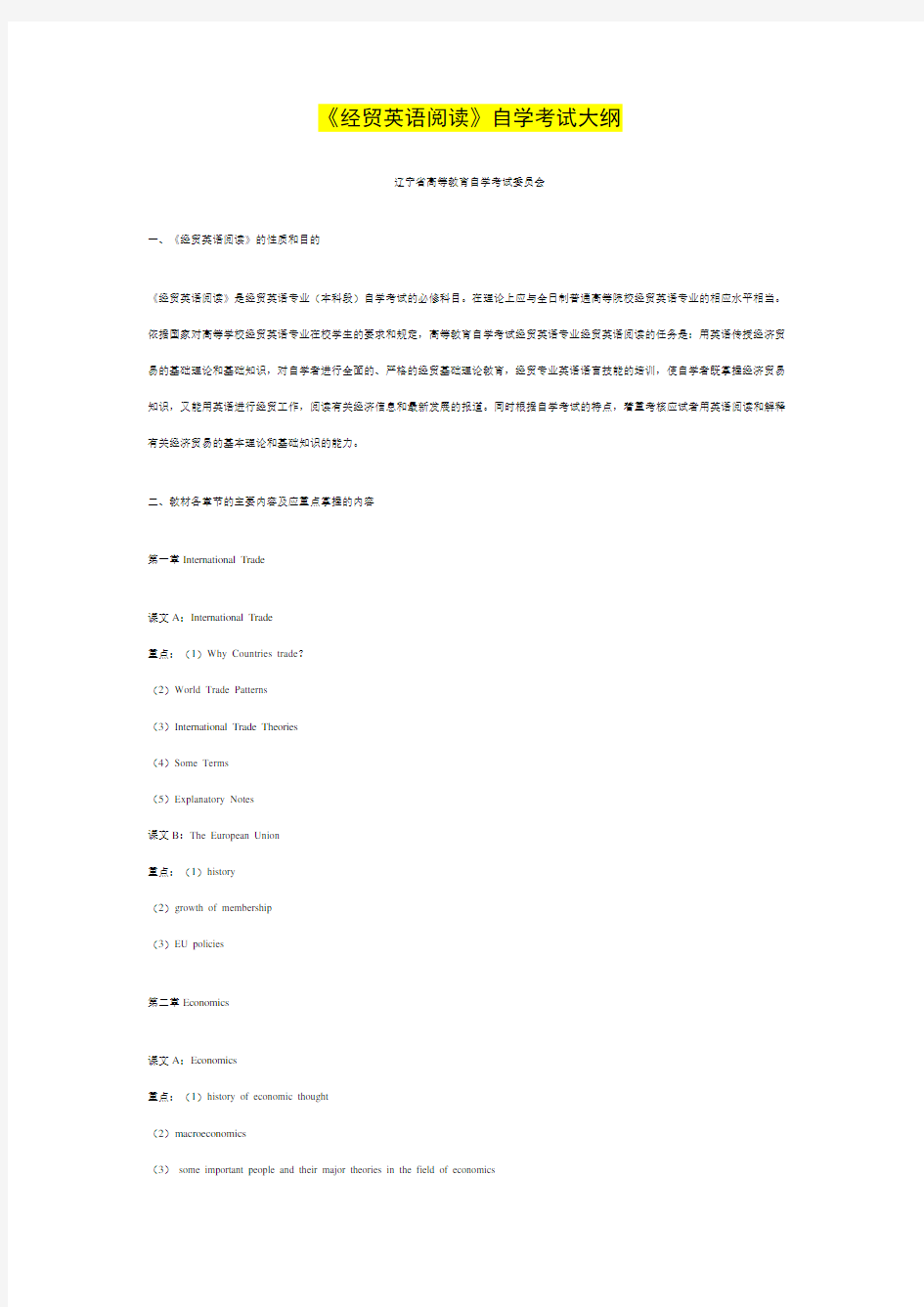

《经贸英语阅读》自学考试大纲
辽宁省高等教育自学考试委员会
一、《经贸英语阅读》的性质和目的
《经贸英语阅读》是经贸英语专业(本科段)自学考试的必修科目。在理论上应与全日制普通高等院校经贸英语专业的相应水平相当。依据国家对高等学校经贸英语专业在校学生的要求和规定,高等教育自学考试经贸英语专业经贸英语阅读的任务是:用英语传授经济贸易的基础理论和基础知识,对自学者进行全面的、严格的经贸基础理论教育,经贸专业英语语言技能的培训,使自学者既掌握经济贸易知识,又能用英语进行经贸工作,阅读有关经济信息和最新发展的报道。同时根据自学考试的特点,着重考核应试者用英语阅读和解释有关经济贸易的基本理论和基础知识的能力。
二、教材各章节的主要内容及应重点掌握的内容
第一章International Trade
课文A:International Trade
重点:(1)Why Countries trade?
(2)World Trade Patterns
(3)International Trade Theories
(4)Some Terms
(5)Explanatory Notes
课文B:The European Union
重点:(1)history
(2)growth of membership
(3)EU policies
第二章Economics
课文A:Economics
重点:(1)history of economic thought
(2)macroeconomics
(3)some important people and their major theories in the field of economics
(4)theories of capital
(5)Explanatory Notes
课文B:National Economy
重点:(1)the circular flow of income and output (2)Keynesian theory
第三章Management
课文A: Overview of Business Management
重点:(1)Types of businesses
(2)business operations
(3)Corporate Finance
(4)Explanatory Notes
课文B:Corporation
重点:(1)development of the corporation
(2)multinational corporations
第四章Marketing
课文A:International Marketing
重点:(1)fundamentals
(2)international pricing
(3)Marketing
(4)Explanatory Notes
课文B:Advertising
重点:(1)introduction
(2)direct advertising
第五章Financial Management
课文A:Banking
重点:(1)commercial banking
(2)banking in Britain and in developing countries (3)roles of banking
(4)The Asian Financial Crisis
(5)Explanatory Notes
课文B: Credit
重点:(1)types and function of credit
(2)credit and the economy
第六章Insurance and Arbitration
课文A:Insurance
重点:(1)reasons for and importance of insurance (2)types of insurance
(3)history of insurance
(4)Explanatory Notes
课文B:Arbitration
重点:(1)labor arbitration
(2)commercial arbitration
第七章Accounting and Statistics
课文A:Accounting
重点:(1)accounting information
(2)accounting principles
(3)bookkeeping
(4)Explanatory Notes
课文B:Statistics
重点:(1)What is statistics?
(2)statistical methods
第八章Taxation and Budget
课文A:Taxation
重点:(1)types of taxes
(2)principles of taxation
(3)Explanatory Notes
课文B:Budget
重点:(1)budgetary process
(2)fiscal policy
第九章Information Technology
课文A: Computer Science
重点:(1)the development of computer science (2)major branches of computer science
(3)Explanatory Notes
课文B: Internet
重点:(1)What is internet?
(2)how the internet works
第十章Intellectual Property
课文A:Intellectual Property
重点:(1)forms of intellectual property
(2)What is patent?
(3)U.S Patent Law
(4)Explanatory Notes
课文B:Copyright
重点: (1)copyright in the United States
(2)international copyright
第十一章The International Legal Environments
课文A:Fundamentals of Law
重点:(1)What is law?
(2)development of law
(3)types of contracts
(4)Explanatory Notes
课文B:Civil Law
重点:(1)characteristics of civil law
(2)Historical development
第十二章International Human Resources Management
课文A:International Human Resources Management
重点:(1)IHRM and organizational structure
(2)Internationalization and the Single European Market (3)European Approach to HRM
(4)Explanatory Notes
课文B:HRM in International Management Development 重点:(1)developing International Management skills (2)essential characteristics of an International Manager (3)Explanatory Notes
第十三章International Investment and Technology Transfer 课文A:Direct Foreign Investment
重点:(1)motivation for DFI
(2)Theories of International Investment
(3)Explanatory Notes
课文B:International Technology Transfer
重点:(1)fundamentals
(2)methods and implications
第十四章Trade in Services
课文A:General Introduction to Trade in Services
重点:(1)nature of trade in services
(2)barriers to Trade Services
(3)Explanatory Notes
课文B:GATS: the Uruguay Round Accord on International Trade and Investment in Services
重点:(1)the Importance of Services Trade and Investment
(2)The General Agreement on Trade in Services
三、命题原则
《经贸英语阅读》课程的考试主要检查考生对本大纲所规定的重点学习内容及相关内容的记忆和理解。其命题原则如下:
(1)合理安排测试能力层次结构。每份试卷中各种能力层次的项目所占的分数比例为:识记20%,理解20%,运用60%。
(2)合理安排测试项目的难易程度结构。题目的难易程度分为易、较易、较难、难四个等级,其比例分别为20%、30%、30%和20%。(3)合理确定教材内、外考核内容的比例。试卷中80%考核教材所学内容,20%测试考生的综合能力。
(4)合理确定教材中重点和非重点部分的比例。70%为本大纲所列的各个单元的重点掌握内容,10%为所规定教材中非重点掌握的内容。
四、考试题型举例
I. What does each of the following abbreviations stand for? (10%)
1. GATT
2. WTO
II. Translate the following terms from Chinese into English(5%)
1. 有形资产
2.贸易集团
III. Translate the following terms from English into Chinese (5%)
1. sales promotion
2. promissory note
IV. Fill in each blank with an appropriate word. (20%)
1. International trade enables countries to use their labor, and other resources in the most productive manner possible.
2. Refers to the methods of producing goods and services that determine efficiency in production.
V. Decide whether the following statements are true (T) or false (F)
(10%)
1. State and local governments depend on sales taxes and property taxes as their main sources of funding.
2. Whereas an income is levied on all sources of income, a payroll tax applies only to wages and salaries.
VI. Reading Comprehension (30%)
Passage 1
A new pay deal, under which long-standing union demarcations are being bought out, has been agreed for workers in Rolls-Royce‘s aero-engines division. It is expected to lead to productivity improvements of up to 70 percent.
The deal has been struck for almost 3,000 workers at the Parkside factory in Coventry and marks the most dramatic of productivity-linked agreements, which have become commonplace in Rolls-Royce in recent years. Coventry pays high wages and as a consequence had to achieve higher productivity improvements.
Mr. Peter Burden, site director at Coventry, said last night: I believe this plan is the springboard for us to become one of the world leaders in the aero-engine industry. We know that we shall be up there in the league table, but what position we occupy will depend very much on our competitors. The Coventry agreement, signed after more than 18 months of negotiations, covers the 2,000 manual workers who will remain at the end of the year after 700 workers have left under a voluntary severance programme.
1. What does the pay deal hope to achieve?
A. To improve productivity by up to 70%.
B. To make the Rolls-Royce union famous.
C. To promote business links between factories in Coventry.
D. To attract more experienced workers.
2. According to Mr. Peter Burden, Rolls-Royce hopes to become one of the leaders in .
A. making union agreements
B. the voluntary severence programme
C. the aero-engine industry
D. employing manual workers
3.In what field are you most likely to find reference to a league table?
A. Sport.
B. Science
C. Education
D. Economy
4.Productivity in this passage refers to.
A .the ability to grow things
B. the rate of making goods
C. the possibility of developing new products
D. the classification of manufactures
VII. Essay Questions (20%)
1. What was of John Maynard Keynes‘s chief argument?
2. What major factors have contributed to the rise in the use of international direct marketing that has occurred in recent years? 后记
辽宁省高等教育自学考试委员会
2002年11月注:题型及分值说明
1.缩略语的扩充10小题,每小题1分,共10分。
2.专业术语汉译英5小题,每小题1分,共5分。
3.专业术语英译汉5小题,每小题1分,共5分。
4.填空20题20空,每空1分,共20分。
5.是非辨认10小题,每小题1分,共10分。
6.阅读理解5-6篇短文,共30分。(含考核综合能力短文20分)
7.简答2小题,每小题10分,共20分。
答案:
I. What does each of the following abbreviations stand for?
1. General Agreement on Tariffs and Trade
2. World Trade Organization
3. gross national product
4. The International Monetary Fund
5. Asia-Pacific Economic Cooperation
6. Organization of Petroleum Exporting Countries
7. European Union
8. Exchange Rate Mechanism
9. Organization for Economic Cooperation and Development
10. Federal Trade Commission
II. Translate the following terms from Chinese into English(5%) 1.physical capital
2. trade block
3. voluntary export restraint
4. market mechanism
5. macroeconomics
III. Translate the following terms from English into Chinese (5%) 1. 促销
2.本票
3.有价证券
4.红利
5. 营业税
IV. Blank filling (20%)
1. capital
2. Technology
3. prices
4. German
5. businesses
6. Macroeconomics
7. macroeconomic
8. merchandisers
9. partnership
10. stock
11. monopoly
12. global
13. marketing
14. Retailing
15. information
16. privately
17. loans
18. indispensable
19. policies
20. income
V. True or false questions: (20%) 1-5TTTFF
6-10 TFTTT
11-15TFFTT
16-20TTFTF
VI. Reading Comprehension
1-5 ACAB D
6-10BBD DD
11-15CACAD
16-20CBDAD
VII. Essay Questions (20%) 1. 参见教材33-34页2.参见教材98页